The Destination Wedding Planners (DWP) Congress, the world’s most influential B2B platform for destination weddings organised by QnA International, today announces its partnership with Sands Lifestyle Macao as the Host Hotel Partner for 2026, taking place from 22 to 24 April 2026 in the vibrant city of Macao.
As the pioneers of the very first platform designed to unite the world’s most influential wedding planners, luxury brands, creative visionaries, and premium hospitality leaders, laying the foundation for the industry’s growth, over the last two decades the DWP Congress 2026 will be hosted in one of the world’s most iconic integrated resort destinations — Macao, a city shaped by Sands China’s cumulative investment exceeding MOP 134.5 billion.





